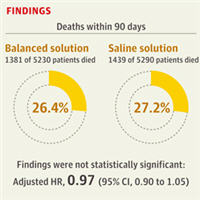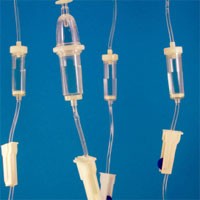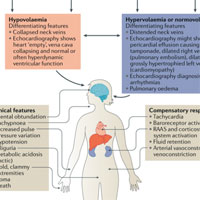Tag: fluid therapy

Balanced Solution vs. 0.9% Saline Solution Fluid Treatment in Critically Ill Patients
Among critically ill patients requiring fluid challenges, use of a balanced solution compared with 0.9% saline solution did not significantly reduce 90-day mortality. The findings do not support the use of this balanced... read more

The Relationship Between Heart Rate and Body Temperature in Critically Ill Patients
In critically ill patients, increased metabolic demand results in increased cardiac output. Increased heart rate in these patients can also be secondary to other conditions such as hypovolemia, heart failure, anxiety, or... read more

Perioperative Fluid Management
This book presents the most recent evidence-based facts on perioperative fluid management and discusses fluid management from basic sciences to clinical applications and the patients’ outcomes. Recent advances in understanding... read more

How I Prescribe CRRT
Continuous renal replacement therapy (CRRT) delivers gradual clearance of solutes, fluid balance control, and haemodynamic stability. CRRT does not appear to increase survival compared to intermittent renal replacement therapy... read more

Mitochondrial Damage-Associated Molecular Patterns Exacerbate Lung Fluid Imbalance Via the Formyl Peptide Receptor-1 Signaling Pathway in Acute Lung Injury
Mitochondrial damage–associated molecular patterns exacerbate lung fluid imbalance in the experimental acute lung injury model through formyl peptide receptor-1 signaling, the inhibition of which may prevent exacerbation... read more

Natriuretic Peptide–driven Fluid Management during Ventilator Weaning
Our results suggest that a BNP-driven fluid management strategy decreases the duration of weaning without increasing adverse events, especially in patients with left ventricular systolic dysfunction. In a randomized controlled... read more

Expert Consensus on Methodology for Conducting and Reporting Echocardiography Research Studies
Echocardiography is a common tool for cardiac and hemodynamic assessments in critical care research. However, interpretation (and applications) of results and between-study comparisons are often difficult due to the lack... read more

Using Dynamic Variables to Guide Perioperative Fluid Management
Intravenous fluid administration is an integral part of patient management during anesthesia. This practice has a strong clinical rationale since a decrease in blood volume, either present before or developing during surgery,... read more

Enteral Fluid Resuscitation? The WHO to the rescue in the ED/ICU?
Prior to the 1970's, restricting oral intake was a "cornerstone" therapy of diarrheal illness, due to the pervasive belief that the GI tract needed time to heal and recover before resuming normal function. This was felt... read more

The End-expiratory Occlusion Test
There is growing evidence that the end-expiratory occlusion (EEO) test reliably detects preload responsiveness. It is easier to perform than passive leg raising and has less limitations than pulse pressure variations, provided... read more

WHO Guidelines Regarding Fluid Administration for Coronarvirus Are Dangerously Misguided
Portions of the current WHO guidelines regarding fluid management are dangerously misguided. The first two recommendations suggest limiting fluid administration in patients with ARDS and patients who aren't shocked, to... read more

Hypertonic vs. Hypotonic, Osmolality, and Other Fun Nursing Concepts
The basic concepts underlying the body's mechanisms for keeping systems functioning are complex processes involving the ebb and flow of fluid and molecules controlled by several systems. It is a delicate balance and one... read more

Automated Anesthetic Management Outperforms Manual Control and May Have an Impact on Delayed Neurocognitive Recovery
Among older, non-frail patients undergoing moderate and high-risk noncardiac surgery, an automated anesthetic management using the combination of three independent closed-loop systems outperformed manual control and may have... read more

Intravenous Fluid Therapy in Critically Ill Adults
Despite the administration of intravenous fluids to critically ill patients being a near-universal intervention, the available evidence base guiding their safe and appropriate use is scarce and derived mainly from academically... read more








